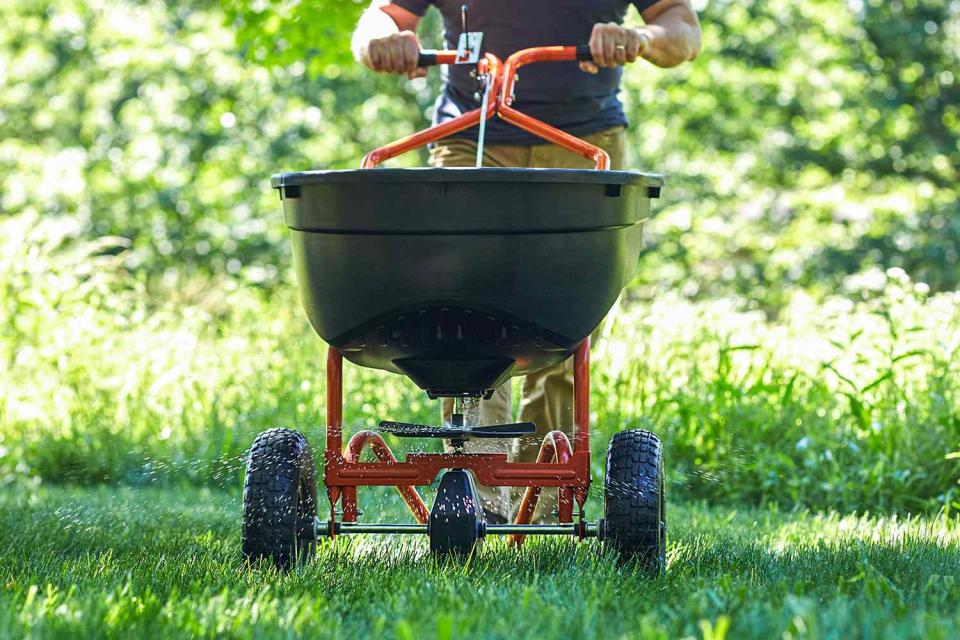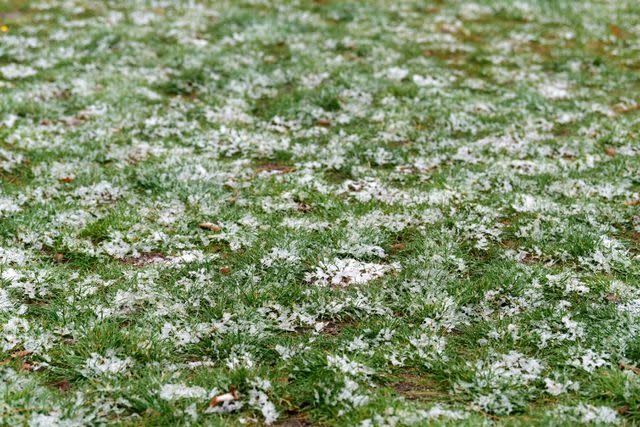The Right Time to Apply Winter Fertilizer on Your Lawn, Explained
Help your lawn wake up from winter ready to go

The Spruce / Adelyn Duchala
Reviewed by Debra LaGattuta
Just because winter arrives doesn't mean your lawn is no longer in need of care. Applying a winter fertilizer to a cool-season grass is the last step in a year-round regimen to keep your lawn looking good.
The time to apply winter fertilizer is just after the grass stops growing in fall, but while it is still green. At this time, the root system is still active, meaning it will be able to absorb the fertilizer. In many parts of the United States, this will be in November-December, but you have to check your state laws to make sure you are allowed to fertilize your lawn at that time.
Different states have their own laws about when you can and cannot fertilize your lawn. Washington, D.C., for example, prohibits fertilizing your lawn between November 15 and March 1.
In this article, we explain what winter fertilizer is, what to look for when purchasing, and how to properly apply a winter fertilizer to achieve its full benefit.
What Is Winter Fertilizer?
Winter fertilizer, also called "winterizer," is a type of lawn fertilizer specifically designed to keep your lawn healthy through winter and put it in an ideal condition to take off once spring returns. Because the grass is no longer actively growing by late fall, the fertilizer you apply in winter feeds your lawn's root system.
How well your grass performs in spring largely depends on how much you help it take advantage of opportunities in fall to become stronger. Fall is the prime season to feed for cool-season turf grass. It's a time for your lawn to strengthen its root system and store nutrients.
If your lawn isn't healthy or you forgot to feed it earlier in the fall, you can apply a winterizer.
The Best Tips for Applying Winter Fertilizer
Applying a winter fertilizer can be an important step for your lawn's health. It helps your grass withstand the damaging effects of freezing temperatures while also giving it a head start once spring arrives.
The ideal day to spread winter fertilizer on your lawn is when heavy rain isn't in the forecast for at least several days. Heavy rainfall washes away fertilizer and runs off into water systems. You want your lawn to be slightly moist so it's ready to accept the fertilizer (several days after rain or watering should be fine), Some lawn fertilizers require watering after application, while others recommend waiting a day or two before watering.
Since winter fertilizer is applied when the grass stops growing, time the application to your last mowing of the year. The shorter grass will help the winter fertilizer reach the the root system where it's needed.
Tip
Be sure to clean up any fertilizer applied to sidewalks, driveways, streets, and other impervious surfaces to prevent fertilizer from washing into nearby storm sewers and bodies of water during rainfall.

The Spruce / Evgeniya Vlasova
How to Choose Winter Fertilizer
Whenever you have to choose a fertilizer, the first question is whether you want to use a synthetic fertilizer or an organic fertilizer, like compost.
If you keep a compost bin and have lots of compost at your disposal, then spreading a thin layer of compost across your lawn is a great, inexpensive option. Compost functions as a slow-release fertilizer, which is great for winter—the idea at this time of year is to prepare the lawn for future success.
In choosing a synthetic winter fertilizer for your lawn, look at the NPK ratio on the fertilizer bag. This ratio consists of three numbers that represent the percentage by weight of nitrogen, phosphorus, and potassium, respectively, contained in the fertilizer.
The fall fertilizer you applied earlier in autumn might have had some phosphorus in it, Your winter fertilizer doesn't need phosphorus. Instead, it will contain nitrogen and potassium, which will be reflected in the NPK ratio.
Tip
A typical ratio for a winter fertilizer will be 21-0-20. The nitrogen will be utilized by the first grass blades that emerge in spring, while the potassium helps the grass cope with the stress it will feel during the cold weather.
Things to Consider When Fertilizing for Winter
As always when using synthetic fertilizers, apply less than the package tells you to. It is safer (but still effective) to use only about 1/2 of the amount of fertilizer recommended in the instructions.
Apply winter fertilizer about 4 to 5 weeks after your earlier application of fertilizer in the fall. If you hold off too long, frozen ground will prevent the winter fertilizer from seeping far enough down into the ground to do much good.
Other Plants that Benefit from Winter Fertilizer
Trees and shrubs shouldn't be fertilized in winter, but you can fertilize in fall, depending on your hardiness zone and your local fertilizer regulations. A fall application of fertilizer before the plant goes into dormancy can support root growth.
As with the lawn, you must fertilize trees and shrubs before the ground freezes so that the nutrients can seep down to the roots. An all-purpose, 10-10-10 fertilizer works great, as it provides nitrogen, phosphorus, and potassium in equal amounts.
To spread fertilizer around trees and shrubs, you can either broadcast it by hand or use a spreader. When applying fertilizer around large trees, avoid the temptation to pile it up around the base of the plant. It is the feeder roots along the dripline of the tree that absorb the most water and nutrients from the soil.
Do You Need to Fertilize Your Lawn in Winter?
Always perform a soil test first to determine if any nutrient deficiencies exist before applying lawn fertilizer. The lawn’s current condition should dictate if it needs feeding, not the calendar.
Read Next: Lawn Care
Read the original article on The Spruce.

